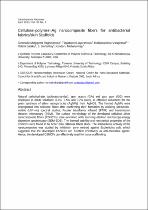 ResearchSpace
ResearchSpace
Cellulose–polymer–Ag nanocomposite fibers for antibacterial fabrics/skin scaffolds
JavaScript is disabled for your browser. Some features of this site may not work without it.
- ResearchSpace
- →
- Research Publications/Outputs
- →
- Journal Articles
- →
- View Item
| dc.contributor.author |
Raghavendra, GM

|
|
| dc.contributor.author |
Jayaramudu, T

|
|
| dc.contributor.author |
Varaprasad, K

|
|
| dc.contributor.author |
Sadiku, R

|
|
| dc.contributor.author |
Ray, SS

|
|
| dc.contributor.author |
Raju, KM

|
|
| dc.date.accessioned | 2013-06-19T11:45:32Z | |
| dc.date.available | 2013-06-19T11:45:32Z | |
| dc.date.issued | 2013-04 | |
| dc.identifier.citation | Raghavendra, G.M, Jayaramudu, T, Varaprasad, K, Sadiku, R, Ray, S.S and Raju, K.M. 2013. Cellulose–polymer–Ag nanocomposite fibers for antibacterial fabrics/skin scaffolds. Carbohydrate Polymers, vol. 93(2), pp 553-560 | en_US |
| dc.identifier.issn | 0144-8617 | |
| dc.identifier.uri | http://www.sciencedirect.com/science/article/pii/S0144861712012581 | |
| dc.identifier.uri | http://hdl.handle.net/10204/6809 | |
| dc.description | Copyright: 2013 Elsevier. This is an ABSTRACT ONLY. The definitive version is published in Carbohydrate Polymers, vol. 93(2), pp 553-560 | en_US |
| dc.description.abstract | Natural carbohydrates (polysaccharides): gum acacia (GA) and gaur gum (GG) were employed in dilute solutions: 0.3%, 0.5% and 0.7% (w/v), as effective reductants for the green synthesis of silver nanoparticles (AgNPs) from AgNO3. The formed AgNPs were impregnated into cellulose fibers after confirming their formation by utilizing ultraviolet–visible (UV–vis) spectral studies, Fourier transforms infrared (FTIR) and transmission electron microscopy (TEM). The surface morphology of the developed cellulose–silver nanocomposite fibers (CSNCFs) were examined with scanning electron microscope-energy dispersive spectroscopy (SEM-EDS). The thermal stability and mechanical properties of the CSNCFs were found to be better than cellulose fibers alone. The antibacterial activity of the nanocomposites was studied by inhibition zone method against Escherichia coli, which suggested that the developed CSNCFs can function effectively as anti-microbial agents. Hence, the developed CSNCFs can effectively used for tissue scaffolding. | en_US |
| dc.language.iso | en | en_US |
| dc.publisher | Elsevier | en_US |
| dc.relation.ispartofseries | Workflow;11151 | |
| dc.subject | Gum acacia | en_US |
| dc.subject | Gaur gum | en_US |
| dc.subject | Carbohydrates | en_US |
| dc.subject | Silver nanoparticles | en_US |
| dc.subject | Cellulose fibers | en_US |
| dc.subject | Antibacterial activity | en_US |
| dc.title | Cellulose–polymer–Ag nanocomposite fibers for antibacterial fabrics/skin scaffolds | en_US |
| dc.type | Article | en_US |
| dc.identifier.apacitation | Raghavendra, G., Jayaramudu, T., Varaprasad, K., Sadiku, R., Ray, S., & Raju, K. (2013). Cellulose–polymer–Ag nanocomposite fibers for antibacterial fabrics/skin scaffolds. http://hdl.handle.net/10204/6809 | en_ZA |
| dc.identifier.chicagocitation | Raghavendra, GM, T Jayaramudu, K Varaprasad, R Sadiku, SS Ray, and KM Raju "Cellulose–polymer–Ag nanocomposite fibers for antibacterial fabrics/skin scaffolds." (2013) http://hdl.handle.net/10204/6809 | en_ZA |
| dc.identifier.vancouvercitation | Raghavendra G, Jayaramudu T, Varaprasad K, Sadiku R, Ray S, Raju K. Cellulose–polymer–Ag nanocomposite fibers for antibacterial fabrics/skin scaffolds. 2013; http://hdl.handle.net/10204/6809. | en_ZA |
| dc.identifier.ris | TY - Article AU - Raghavendra, GM AU - Jayaramudu, T AU - Varaprasad, K AU - Sadiku, R AU - Ray, SS AU - Raju, KM AB - Natural carbohydrates (polysaccharides): gum acacia (GA) and gaur gum (GG) were employed in dilute solutions: 0.3%, 0.5% and 0.7% (w/v), as effective reductants for the green synthesis of silver nanoparticles (AgNPs) from AgNO3. The formed AgNPs were impregnated into cellulose fibers after confirming their formation by utilizing ultraviolet–visible (UV–vis) spectral studies, Fourier transforms infrared (FTIR) and transmission electron microscopy (TEM). The surface morphology of the developed cellulose–silver nanocomposite fibers (CSNCFs) were examined with scanning electron microscope-energy dispersive spectroscopy (SEM-EDS). The thermal stability and mechanical properties of the CSNCFs were found to be better than cellulose fibers alone. The antibacterial activity of the nanocomposites was studied by inhibition zone method against Escherichia coli, which suggested that the developed CSNCFs can function effectively as anti-microbial agents. Hence, the developed CSNCFs can effectively used for tissue scaffolding. DA - 2013-04 DB - ResearchSpace DP - CSIR KW - Gum acacia KW - Gaur gum KW - Carbohydrates KW - Silver nanoparticles KW - Cellulose fibers KW - Antibacterial activity LK - https://researchspace.csir.co.za PY - 2013 SM - 0144-8617 T1 - Cellulose–polymer–Ag nanocomposite fibers for antibacterial fabrics/skin scaffolds TI - Cellulose–polymer–Ag nanocomposite fibers for antibacterial fabrics/skin scaffolds UR - http://hdl.handle.net/10204/6809 ER - | en_ZA |





